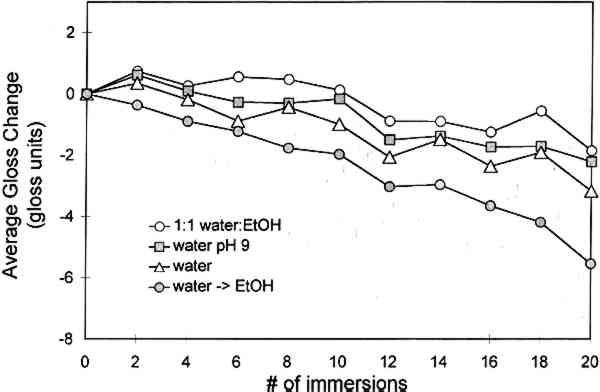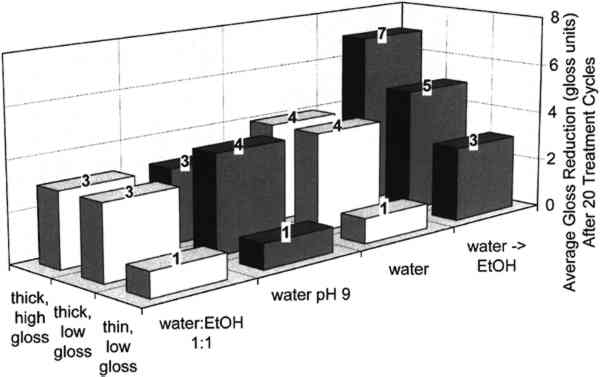THE EFFECTS OF FOUR DIFFERENT WET TREATMENTS ON ALBUMEN PHOTOGRAPHS
VALERIE BAAS, CHRISTOPHER FOSTER, & KAREN TRENTELMAN
3 RESULTS
Gloss was diminished in all of the samples in the study as a result of the aqueous treatments, and the amount of change in gloss was found to be related to the type of bath treatment. The average gloss change for all the samples in the study as a function of the number of immersions in each of the four treatment baths is presented in figure 1. The least reduction in gloss was observed for the samples treated with the water:ethanol (1:1 v:v) mixture (bath C). The water bath at pH 9 (bath B) and the water-only bath (bath A) resulted in only slightly more reduction than bath C. However, a significantly greater reduction in gloss was observed in the samples bathed in water followed immediately by ethanol (bath D).
Fig. 1.
The average decrease in gloss for all prints in the study as a function of the number of immersions in each of the four treatment baths. The water:ethanol mixture consistently showed the least reduction in gloss, while the bath of water followed by ethanol showed the greatest gloss reduction. The standard deviation of the values ranges from approximately 1 to 2 gloss units.
 |
Although all three paper types exhibited the trend discussed above, differences in the magnitude of gloss reduction were observed among the print types. The average change in gloss after 20 treatment cycles produced by each treatment bath as a function of the initial gloss and thickness of each sheet is presented in figure 2. There appears to be a relationship between the thickness of the albumen coating and the change in gloss: samples with a thicker coating suffered a greater reduction in gloss than samples with a thinner coating. The figure also shows that the reduction in gloss does not appear to be related to the initial gloss of the print.
Fig. 2.
The average change in gloss over the course of the 20 treatment cycles for each of the three paper types in each of the four treatment baths. The bath of water followed by ethanol shows the greatest reduction in gloss, while the other three baths are quite similar, although the water:ethanol mixture does show slightly less gloss reduction. The thicker (∼0.10 mm) prints show a greater reduction in gloss than the thinner (∼0.09 mm) prints, regardless of the initial gloss.
 |
|

